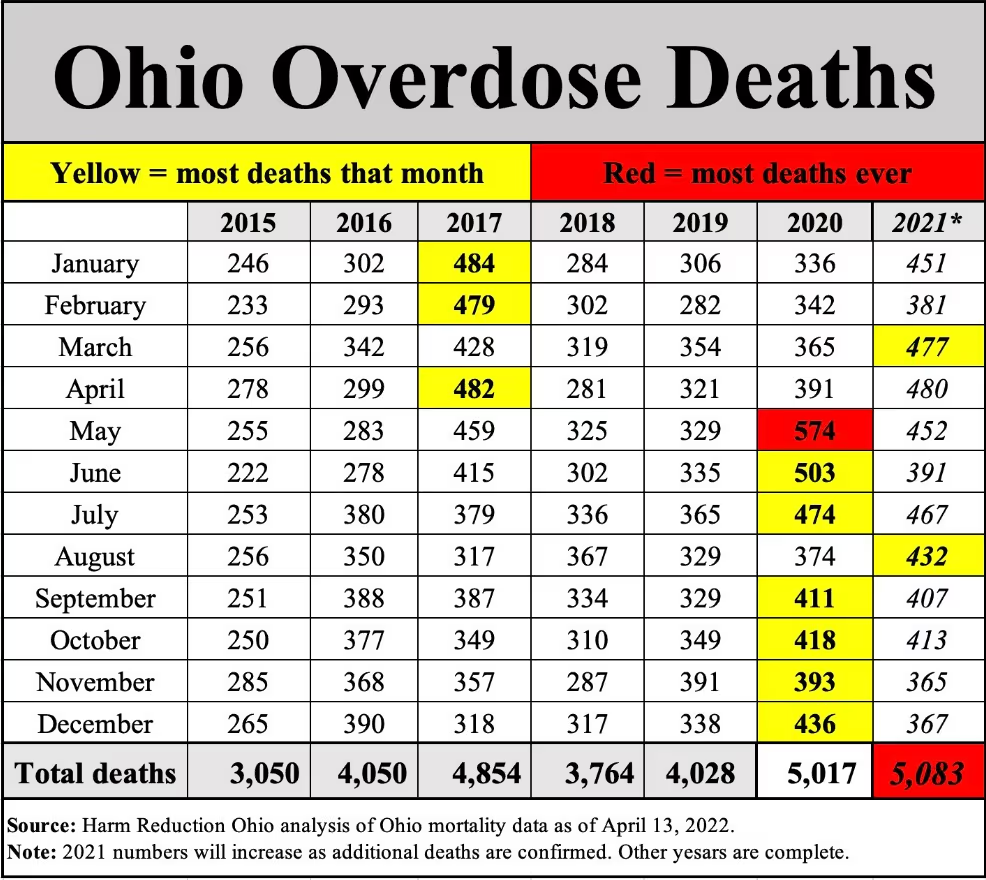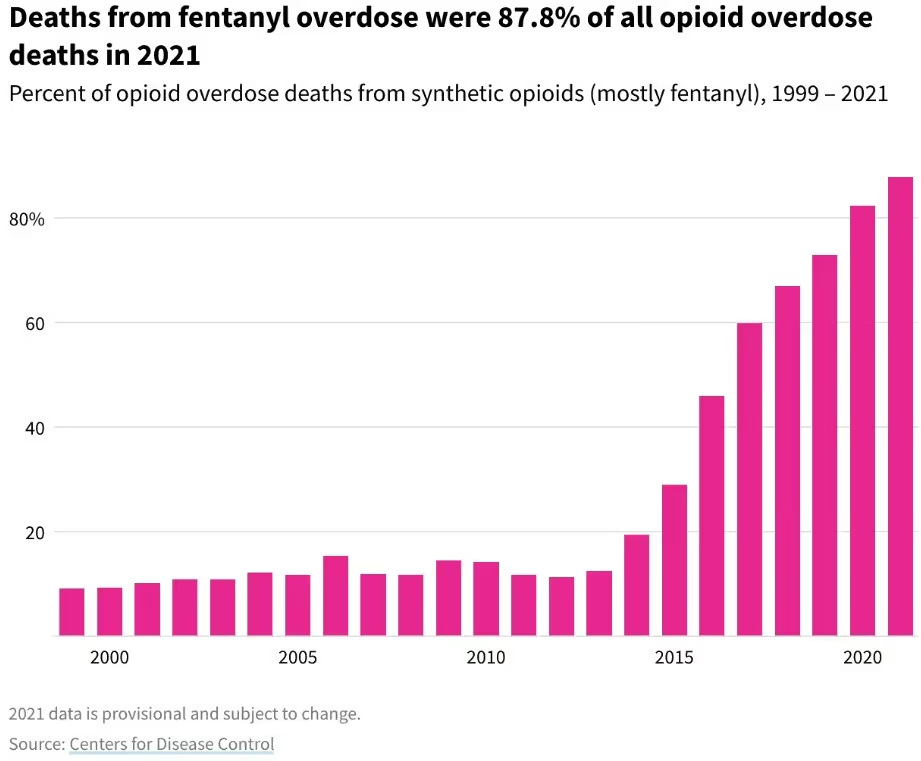How Many People Have Died from Opioids in Ohio?

How Many People Have Died from Opioids in Ohio?
Opioid addiction is a major problem in America, and Ohio is no exception. The opioid epidemic has devastated families and communities across the state. With so many lives lost, it's important to understand the scope of the problem. In this article, we will explore how many people have died from opioids in Ohio and what is being done to address this crisis.

According to the Ohio Department of Health, the number of unintentional drug overdose deaths in Ohio reached a staggering 4,293 in 2020, which is a 26.8% increase from the previous year. This is a deeply concerning trend that highlights the severity of the opioid epidemic in Ohio, which has been a major public health crisis for many years.
In fact, opioids were involved in 90.4% of all overdose deaths in Ohio in 2020, indicating that this is the primary driver of the epidemic. The impact of this crisis can be seen clearly when we compare it to the situation just a decade ago. In 2010, there were 1,544 drug overdose deaths in Ohio. This means that the number of overdose deaths has more than doubled in just ten years.

Despite efforts to combat this epidemic, it is clear that much more needs to be done to address this issue effectively. The rising death toll is not only tragic but also represents a significant public health challenge that requires a coordinated and sustained response from government agencies, healthcare providers, and communities across Ohio. Only by working together can we hope to stem the tide of this devastating epidemic and save lives.
Prevalent Abuse of Opioid
Opioid abuse is a widespread problem in Ohio, affecting people of all ages and backgrounds. Many individuals who become addicted to opioids are first introduced to the drugs through prescription painkillers. These highly addictive medications can quickly lead to dependence and, in many cases, addiction.
Unfortunately, the prevalence of opioid abuse in Ohio has been on the rise for many years. This is due in part to the ease with which these drugs can be obtained illegally, as well as a lack of access to effective treatment options for those struggling with addiction. In addition to prescription painkillers, other opioids such as heroin and fentanyl are also frequently abused in Ohio.
The impact of opioid abuse on individuals and communities across Ohio cannot be overstated. Those struggling with addiction often face significant challenges when it comes to accessing healthcare services, finding employment, and maintaining stable relationships with family and friends. Additionally, the economic costs associated with opioid abuse are staggering, including lost productivity, increased healthcare costs, and strain on public resources such as law enforcement agencies.
Given the scope of this problem, it is clear that more needs to be done at all levels of society to address the root causes of opioid abuse and support those struggling with addiction. This may include increased funding for addiction treatment programs, greater education efforts aimed at preventing opioid use among vulnerable populations, and stronger regulation of prescription painkillers to prevent misuse and abuse. By working together to tackle this crisis head-on, we can begin to turn the tide against opioid addiction in Ohio and help those affected by this devastating epidemic find hope and healing.
The Role of Fentanyl in the Opioid Epidemic
One of the key factors contributing to the surge in opioid-related deaths is the widespread availability of fentanyl. Fentanyl is a synthetic opioid that is 50-100 times more potent than morphine, making it a highly effective painkiller for medical use. However, it has also become a major contributor to the opioid epidemic, as it is often mixed with other drugs, such as heroin or cocaine, to increase their potency.
The problem with fentanyl is that it is extremely dangerous and can easily lead to an overdose. Because it is so potent, even a small amount can be lethal. This risk is amplified by the fact that many people who use drugs laced with fentanyl are unaware of its presence, as it is often added to other substances in secret.
Fentanyl is an incredibly potent synthetic opioid that poses a serious risk to public health in the United States. According to the United States Drug Enforcement Administration (DEA), just 2mg of fentanyl can be lethal, particularly for people with no opioid tolerance. To put this into perspective, 2mg of fentanyl is roughly equivalent to:
- Two grains of salt
- Two sugar packets
- A pinch of powdered sugar
The statistics surrounding the opioid epidemic are alarming. Opioid deaths rose 38% nationally from January 2020 to January 2021, highlighting the severity of the crisis. Perhaps most concerning, fentanyl is now responsible for more deaths of Americans under the age of 50 than any other cause of death, including heart disease, cancer, homicide, suicide, and other accidents. For example:
- In Ohio, fentanyl was involved in over 75% of all opioid-related deaths in 2019
- In Massachusetts, fentanyl was responsible for over 93% of opioid-related deaths in 2019
Recognizing the urgent need to address this crisis, the U.S. Food and Drug Administration (FDA) has approved certain medications and treatments to help patients cope with the symptoms of fentanyl withdrawal. These include opioid and non-opioid options such as:
- Methadone: an opioid medication that can help reduce cravings and symptoms of withdrawal
- Buprenorphine: a partial opioid agonist that can help manage symptoms of withdrawal and reduce cravings
- Naltrexone: a non-opioid medication that blocks the effects of opioids and can reduce cravings
- Behavioral therapy: a type of counseling that can help patients learn coping skills and develop healthy habits
According to the Centers for Disease Control and Prevention (CDC), fentanyl was involved in over 60% of all opioid-related deaths in the United States in 2019. This represents a significant increase from previous years and underscores the severity of the crisis. It also highlights the urgent need for better regulation and control of fentanyl and other synthetic opioids to prevent further harm.

While these treatments can be effective, they are not a cure-all and must be used as part of a broader strategy to address the root causes of addiction and prevent further harm.

Ultimately, addressing the fentanyl crisis will require a multi-faceted approach that includes better regulation and control of dangerous substances, increased access to addiction treatment and support services for those struggling with substance use disorders, and greater public awareness about the dangers of opioid abuse.
By working together to address these challenges, we can begin to make progress towards ending this devastating epidemic once and for all.
The Role of Prescription Opioids in the Opioid Epidemic in Ohio
Prescription opioids have played a significant role in fueling the opioid epidemic in Ohio. Many individuals who become addicted to opioids start with prescription painkillers such as oxycodone, hydrocodone, and codeine. These medications are highly addictive and can lead to dependence even when taken as prescribed.
One major issue contributing to the overuse of prescription opioids is the lack of oversight and regulation by healthcare providers. In many cases, doctors prescribe these medications without fully considering their risks or potential for addiction. Additionally, patients may be given larger quantities of medication than they need, leading to unused pills that can be diverted for illicit use.
This problem is particularly acute in rural areas where access to healthcare services may be limited. Patients may find it difficult to obtain alternative treatments for pain management or receive adequate counseling about the risks associated with opioid use.
Addressing this issue will require a concerted effort by policymakers, healthcare providers, and communities across Ohio. This may include better education about the risks associated with prescription opioids, stronger regulations around prescribing practices, and increased access to alternative forms of pain management such as physical therapy or acupuncture.
By addressing the root causes of overprescribing and misuse of prescription opioids in Ohio, we can begin to make progress towards ending this devastating epidemic once and for all.
Ohio's Efforts to Combat the Opioid Epidemic
Ohio has been hit hard by the opioid epidemic, but the state has taken significant steps to address this crisis. In 2017, Governor John Kasich signed the Ohio Opioid Action Plan, a comprehensive strategy that includes a range of initiatives aimed at combatting the epidemic.
One of the key components of the Ohio Opioid Action Plan is increasing access to naloxone, a medication that can reverse an opioid overdose. Naloxone is now available in many pharmacies throughout Ohio without a prescription, making it more accessible to those who need it. This has saved countless lives and is an important tool in the fight against the opioid epidemic.
The Ohio Opioid Action Plan also includes initiatives to increase access to treatment for those struggling with addiction, improve data collection and analysis to better understand and respond to the crisis, and increase public awareness about the dangers of opioids.
In addition to these efforts, Ohio has also taken legal action against opioid manufacturers and distributors. The state has filed lawsuits alleging that these companies engaged in deceptive marketing practices that contributed to the opioid epidemic. The hope is that these lawsuits will hold these companies accountable and provide funding for addiction treatment and prevention programs.
Overall, Ohio's approach to addressing the opioid epidemic is multi-faceted and comprehensive. It recognizes that there is no single solution to this complex problem and that a range of strategies are needed to make progress towards ending this devastating crisis.
The Devastating Impact of Opioid Addiction on Families and Communities in Ohio
The opioid epidemic has had a profound impact on families and communities across Ohio. When individuals struggle with addiction, their loved ones often bear the brunt of the consequences. Families may experience financial strain, loss of employment, and emotional turmoil as they try to support their loved one through recovery.
In addition to the toll on individual families, the opioid epidemic has also had a broader impact on communities across Ohio. As addiction rates have risen, so too have rates of crime, homelessness, and other social issues. Many communities have seen increased strain on public resources such as law enforcement agencies and healthcare providers as they work to address the crisis.
Moreover, children are often severely impacted by parental substance abuse. Parental addiction can lead to neglect or abuse of children, resulting in long-term physical and psychological harm. Children may be removed from their homes by child welfare services or placed in foster care due to their parents' substance use disorders.
Addressing the impact of opioid addiction on families and communities will require a multi-pronged approach that includes access to effective treatment for those struggling with addiction as well as support for affected families and communities. This may include counseling services for family members dealing with stress or trauma related to a loved one's addiction, education programs aimed at raising awareness about the dangers of opioids, and community-based initiatives that foster resilience and support networks.
By recognizing the devastating impact that opioid addiction can have on families and communities across Ohio, we can begin to develop more effective strategies for addressing this crisis. By working together at all levels of society - from policymakers to healthcare providers to community members - we can begin to make progress towards ending this epidemic once and for all.
Conclusion
In conclusion, the opioid epidemic in Ohio has claimed far too many lives. The number of overdose deaths involving opioids continues to rise, and the problem is not going away. However, Ohio has taken steps to address the crisis, including increasing access to treatment and naloxone and filing lawsuits against opioid manufacturers and distributors. It is important for individuals and communities to continue to work together to combat the opioid epidemic and save lives.
Sources:
- Ohio Department of Health. (2021). Drug Overdose in Ohio: Deaths Involving Opioids. Retrieved from https://odh.ohio.gov/wps/portal/gov/odh/know-our-programs/vital-statistics/Drug-Overdose-in-Ohio-Deaths-Involving-Opioids/
- Ohio Opioid Education Alliance. (n.d.). Ohio's Opioid Action Plan. Retrieved from https://dontliveindenial.org/ohio-opioid-action-plan/
